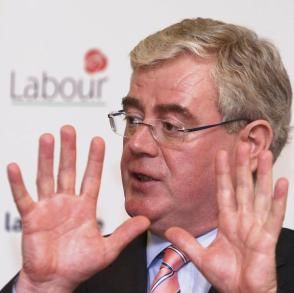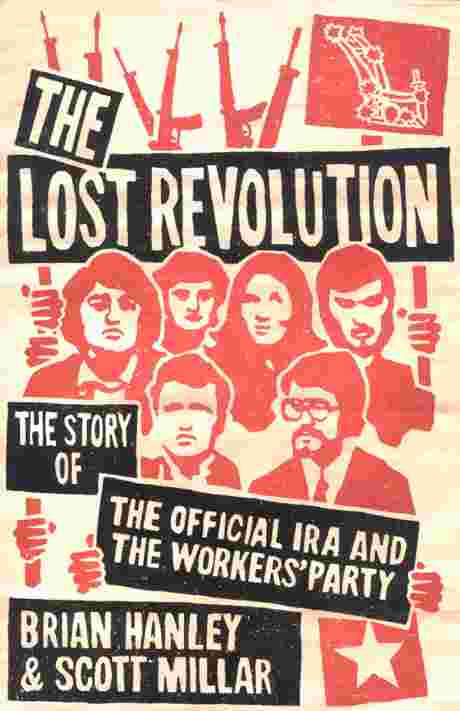Why the silence from the media about Eamon Gilmore’s Sticky past?
 national |
politics / elections |
other press
national |
politics / elections |
other press  Wednesday February 23, 2011 00:07
Wednesday February 23, 2011 00:07 by Paul Larkin
by Paul Larkin
The Meida blind eye to the Workers Party
During the election campaign, the media has singularly failed to put the hard questions to former members of the Workers Party
Anyone who saw Ryan Tubridy’s disgraceful, not to say disrespectful, treatment of Sinn Féin leader Martin McGuinness on the Late Late Show recently, will understand that RTÉ has a problem. With some honourable exceptions, its senior journalists and broadcasters do not do “balance”.
Rather, they let their middle class Dublin 4 psychosis show when interviewing anyone from a radical, Irish Republican background; unless of course, the interviewee is a former member of Official Sinn Féin – later the Workers Party. If this applies, the interviewee will almost never be asked about his or her political past. This, of course, is good news for ex Workers Party politicians who now, effectively, form the leadership of the Labour Party.
Before turning to Eamon Gilmore – I wish to raise just one question with regards to Tubridy’s interview:
Would Tubridy show the Reverend Ian Paisley or, say, former RUC chief and head of RUC Special Branch, Ronnie Flanagan such disrespect? The answer is, of course, no.
For RTÉ, Paisley and Flanagan are legitimate people, whilst Sinn Fein is just a legitimate target. Tubridy’s palpable distaste for McGuinness simply reflects the unspoken approach of the station as a whole. Tubridy, it should be said does not have an Official Republican background. He was once a member of the Kevin Barry Fianna Fáil Cumann at UCD. One wonders what Kevin Barry would make of him now.
Let me be clear and state that I am not seeking preferential treatment for Sinn Féin. Quite the opposite. I am simply seeking cothrom féinne - equal treatment. Ryan Tubridy spent some ten minutes wasting national broadcasting time spraying McGuinness with scatter gun questions about his IRA past before then proceeding to grill him about Gerry Adams and the IRA.
The question is, will Tubridy, or some scion of Irish broadcasting, now give Labour leader Eamon Gilmore the same treatment?
The occasionally choleric Gilmore would bust a blood vessel at the suggestion that there was any equivalence between himself and, say, Martin McGuinness but, whether Gilmore likes it or not (and regardless of the fact that RTÉ wants to ignore the issue), the leader of the Labour Party does have questions to answer.
Now, I have never seen or heard any evidence to suggest that Gilmore was ever on the army council of the Official IRA in the way that Adams and McGuinness once led the Provisional IRA, but the fact is that he was a leading member of the Official IRA’s political wing and this, surely, raises similar questions to the ones that McGuinness and Adams face ad nauseam. Guilt by association becomes selective when it comes to Tubridy et al.
In fact, the grilling that Gilmore should face ought, in some ways, to be more severe because (as we shall see below) the armed wing that was undeniably linked to his party abandoned all pretence of political activity very early in its political life. It simply became an armed gang – a criminal conspiracy dressed up in fake Irish Republican fatigues. Is this not meat and drink to any good news hunting journalist? It may well be that Gilmore had no idea of his party's links to the Official IRA but the Irish public will never know this unless he is asked in a public media forum.
Eamon Gilmore joined the University College Galway Republican Club, affiliated to ‘Official Sinn Féin’ (later the Workers’ Party), around 1975. 1975 was the year that the Officials started a feud in Belfast by executing the unarmed Hugh Ferguson in Ballymurphy because he broke away from the organisation and supported the Irish Republican Socialist Party. Two years later, the Officials shot dead Seamus Costello in Dublin. Gilmore remained a member of the “Sticks” throughout this whole period of Official IRA activity and just to emphasise the point, Gilmore’s university branch in Galway sold the party’s newspaper at that time, which carried lists of Official IRA prisoners, north and south.
Eamon Gilmore remained a member of the Official Republican party right up to the point when most of its TDs (including himself) broke away in 1992 to set up a new party - Democratic Left. Democratic Left then merged with the Labour Party in 1999 and its, allegedly, brightest acolytes then took prominent positions in what we might call New Labour. Now Gilmore leads Labour.
The Labour leader will presumably reply that he knew nothing of any armed conspiracy purporting to be the Official IRA and making claims to be the army of what became the Workers Party, but then those “meat and drink” journalists would simply begin to question his judgement by asking how he managed to miss an armed criminal gang – almost sticking to his nose as it were.
Readers who want to know more about the Official IRA really should go out and buy a book called “The Lost Revolution”, by Brian Hanley and Scott Millar and published by Penguin Ireland – 2009. My references to the book below refer to the soft cover, large format version of the first imprint.
Before I go on, very briefly, to praise this book I should say that I am surprised that the authors failed to contact either myself or BBC reporter Shane Harrison given that we made the film in 1991, which proved to be the final straw that broke the Stickies' back. It should also be said that the authors themselves don’t seem to realise the full significance of the content of the interview material that they produce. I provide just one startling example of this below.
What the book does reveal, however, is very significant. For the first time, for example, it lays bare the extent of the conscious infiltration of RTÉ by a group, which can only be described as Pro Unionist and Machiavellian. In fact, the secret placing of undercover Workers Party members within the media became so widespread that party members themselves began to call for the “sleepers” to either declare themselves or leave the party.
More fundamentally, the book clearly shows that the Workers Party relied heavily on proceeds from, building site scams (an allegedly Socialist party putting workers on “The Lump”), bank robberies and other criminal operations like counterfeiting. This may be the reason that key Official IRA leaders in Belfast took a policy decision not only to work with a corrupt anti Irish police force (the RUC) but also to work hand in hand with the criminal fraternity. This policy was replicated in the Dublin area. “Lost Revolution” really is excellent in revealing all this.
There is a key passage in the book (pages 563-564) which refers to “Group B” (Official IRA) activities in 1990 and its continued importance to the survival of the Workers Party (where, bear in mind, Eamon Gilmore is still a leading member):
“Group B’s continued importance was evident in a financial report…in October 1990. From October 1989 until September 1990, costs covered by party head office had amounted to £360,300, of which WP funds provided £189,900 with the balance of £170,600 met by Repsol.”
"Repsol" was the Workers Party’s printing/publishing arm. At the same time as printing political tracts and pamphlets, it also ran a counterfeiting operation and was used to launder money gained from criminal activities. Here “Lost Revolution” is repeating what we said in our film for the BBC, which was that the Official IRA was at that time, still clearly linked to the Workers Party and was helping to finance its operations.
It is true that the book’s authors go on to state that it is not clear how widespread the understanding was within the party where Repsol’s activities were concerned. However, in an astonishing claim on page 564, the authors publish evidence from two “leading activists” who state that in 1989 the then Workers Party leader Proinsias De Rossa received “a clear commitment to halt all Group B ‘special activities” from Group B leader and Official IRA veteran Sean Garland:
"Two leading activists recall that in the period following the 1989 election De Rossa received from Garland a clear commitment to halt all Group B 'special activities', and some Group B activists were informed that a decision had been made to disband the organisation."
The reason why the above statement is so surprising is that Proinsias De Rossa seems to have cooperated with the authors in the writing of the book by providing an interview and, presumably, background information. He is listed as an interviewee in the back of the book. Yet there has been no challenge from De Rossa about the above statement in the book, which clearly alleges that he was, as Workers Party leader, aware of Official IRA/Group B activities as late as 1989.
In the early 1990s, with De Rossa now head of Democratic Left, he successfully sued Eamon Dunphy over an article in the Sunday Independent, which the libel jury decided falsely alleged that, De Rossa, was involved in or tolerated serious paramilitary crime, was anti-Semitic and supported violent communist oppression. De Rossa was awarded IR£300,000.
What now does De Rossa have to say about the claims in "Lost Revolution" that in 1989 he received an assurance from the Official IRA that it would cease its activities? (The authors go on to say, quite rightly, that the organisation did not cease its activities.)
And if the Workers Party leader was aware of OIRA’s activities, as the authors claim, where does that place the likes of Eamon Gilmore who was, after all a close colleague of De Rossa at that time?
Will some RTÉ journalist (or indeed any senior journalist) now step up to the plate and ask Eamom Gilmore what, if anything, he knew, about the links between the Workers Party and the Official IRA? After all, they have used this approach year in year out in their reporting of the Provisional Sinn Féin leadership.

